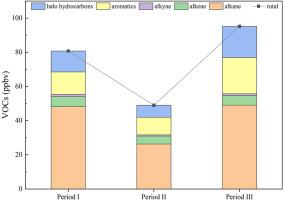Atmospheric Pollution Research ( IF 4.5 ) Pub Date : 2024-01-29 , DOI: 10.1016/j.apr.2024.102064 Dandan Li , Xuemei Tao , Xia Song , Shuo Liu , Kai Yuan , Fulin Deng , Yongtao Guo

|
During the COVID-19 lockdown, PM2.5, ozone and precursor NOx were widely reported, but changes on volatile organic compounds (VOCs) were scarcely reported. It is important to understand the impact of drastic changes in anthropogenic emissions on the levels of VOCs. In this study, VOCs were collected with Summa tank for monitoring before (Period I), during (Period II) and after (Period III) the COVID-19 lockdown in Lanzhou, Northwest China. During the lockdown, the average concentration of VOCs was 49.01 ± 20.63 ppbv, the total mixing ratio was 39.3 % and 48.5 % lower than Period I and Period III, at the same time alkanes, alkenes, aromatics, halo hydrocarbons decreased by 45.5 % and 46.4 %, 20.2 % and 15.1 %, 21.0 % and 51.4 %, 42.9 % and 61.6 %, respectively. The ratio of benzene/toluene (B/T) increased from 0.85 (Period I) to 1.40 (Period II) and finally to 1.83 (Period III). The trend of isobutane to n-butane (IB/NB)was 0.28 (Period I)-0.75 (Period II)-0.92 (Period III). The above results indicated that traffic source contribute more to VOCs in the Period I, and natural gas, coal and biomass combustion are the main sources during the Period II and III. The xylene/ethylbenzene (X/E) ratio showed a tendence higher in the middle (1.42) and lower on both sides (0.78 and 0.57, respectively), which indicated that the aging of gas masses during the lockdown is lower than Period I and III. Five factors resolved by the positive matrix factorization (PMF) model were Liquefied Petroleum Gas (LPG) and vehicle exhaust emission, biomass/coal burning, industrial coatings/solvents, industrial process and gasoline exhaust. The source apportionment calculation consistent with the ratio of B/T and IB/NB showed that the contribution of biomass/coal burning increased from 13.1 % (Period I) to 21.8 % (Period II), while the contribution of LPG and vehicle exhaust emission decreased from 45.8 % to 31.5 %.



























 京公网安备 11010802027423号
京公网安备 11010802027423号